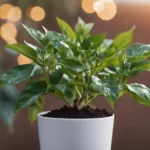Peace Lilies, with their elegant white blooms and lush green leaves, have earned their place as popular indoor plants, bringing a touch of serenity to homes and offices. However, the joy of owning a Peace Lily can be dampened when its once vibrant green leaves start developing brown tips. If you’ve found yourself wondering, “Why are the tips of my Peace Lily turning brown?” fear not – in this article, we’ll unravel the mysteries behind this common issue and guide you on how to restore your Peace Lily to its former glory.
- Tailored Nutrient Blend: Our indoor houseplant fertilizer is formulated with a precisely balanced blend of nutrients, ensuring your plants receive the specific nourishment they need for robust growth and vibrant foliage.
- Optimal Absorption: The unique liquid formulation is designed for efficient nutrient absorption, delivering essential elements directly to the roots and leaves, resulting in quicker and more noticeable plant health improvements.
- Indoor Environment Focus: Developed with indoor plants in mind, our fertilizer takes into account the specific conditions of indoor settings, providing nutrients that cater to the controlled environment of your home.
- Enhanced Growth Patterns: Our fertilizer encourages and supports growth patterns that are well-suited to indoor spaces, helping your plants thrive without excessive stretching or sprawling.
- Mess-Free Application: Applying our specially crafted fertilizer is simple and mess-free, with easy-to-follow instructions. No more worrying about soil spills or residue on your indoor surfaces.
Normal Leaf Behavior
Before jumping into potential problems, it’s essential to understand that a certain degree of browning at the tips of Peace Lily leaves can be a natural part of the plant’s life cycle. As individual leaves age, it’s not uncommon for their tips to turn brown. This process is often the result of the leaf’s natural aging, and it doesn’t necessarily indicate a problem with the overall health of the plant.
To distinguish between normal leaf aging and abnormal browning, observe the pattern and extent of the discoloration. If the browning is limited to older leaves and occurs gradually, it might be within the realm of normal leaf behavior. However, if the browning is widespread, affects newer leaves, or happens rapidly, it’s time to investigate potential issues related to care, environment, or other factors.
Inadequate Watering
One of the most common reasons for browning Peace Lily tips is inadequate watering. Peace Lilies are sensitive to changes in soil moisture, and both underwatering and overwatering can manifest as browning at the leaf tips. If you notice dry, crisp brown tips, it may indicate that the plant is not receiving enough water. On the other hand, if the tips are soft and mushy, overwatering could be the culprit.
Finding the right balance is crucial. Peace Lilies prefer consistently moist but not waterlogged soil. Water the plant thoroughly, allowing excess water to drain, and then wait until the top inch of soil feels slightly dry before watering again. Adjusting your watering routine based on the specific needs of your Peace Lily and the environmental conditions will help maintain optimal soil moisture and prevent browning tips.
Lighting Issues
Proper lighting is paramount for the health of Peace Lilies, and lighting issues can contribute to browning tips. Peace Lilies thrive in indirect, filtered light. Exposure to too much direct sunlight can scorch the leaves, leading to brown tips. Conversely, insufficient light can result in slow growth and pale leaves.
To address lighting issues, ensure your Peace Lily is placed in a location with bright, indirect light. Shield it from intense, direct sunlight, especially during the peak hours of the day. If your plant is showing signs of insufficient light, consider moving it to a brighter spot or supplementing with artificial light sources designed for indoor plants.
Humidity Levels
Peace Lilies hail from tropical regions and favor higher humidity levels. In dry indoor environments, especially during the winter months or in air-conditioned spaces, the humidity around the plant can drop, leading to browning leaf tips. Signs of low humidity also include slow growth and curled leaves.
To boost humidity, consider placing a tray filled with water and pebbles near the Peace Lily. Grouping plants together or using a room humidifier can also create a more favorable microclimate. Regularly misting the leaves can provide a quick humidity boost, but be cautious not to overdo it, as excessive moisture on the leaves can lead to other issues.
Soil Quality and Fertilization
The quality of the soil and the fertilization routine play crucial roles in the overall well-being of Peace Lilies. These plants thrive in well-draining soil, and poor soil quality or excessive fertilization can result in browning leaf tips. Compacted or heavy soils can hinder water drainage, leading to stress and potential root issues.
Ensure your Peace Lily is potted in a well-draining mix suitable for houseplants. When fertilizing, follow a moderate and consistent routine, avoiding the temptation to over-fertilize, as excess salts from fertilizers can accumulate in the soil, causing browning tips. Use a balanced, water-soluble fertilizer, and dilute it to half the recommended strength during the growing season.
Maintaining a healthy soil structure and providing balanced nutrition will contribute to the overall vitality of your Peace Lily, reducing the likelihood of browning at the tips of its leaves. In the upcoming sections, we will explore root health, pest infestations, and temperature considerations as potential factors in the browning of Peace Lily tips.
- Comes in a High-Quality Resealable Pouch for Future Use
- Excellent Houseplant Soil Mix – Provides Optimal Water Content
- Made Fresh Every Day in Small Handcrafted Batches from the Finest Ingredients from All Over the World
- A Brand You Can Trust. Our Mixes are Used by Some of the Largest Conservatories and Botanic Gardens in the World!
Root Health and Pot Size
The well-being of Peace Lilies is intimately tied to the health of their roots and the size of their pots. Over time, Peace Lily roots may become crowded, leading to stress and, eventually, browning leaf tips. Check the root system by gently removing the plant from its pot. If you observe roots circling the pot or forming a dense mass, it’s a sign that repotting may be necessary.
When repotting, select a pot that provides ample space for root expansion. A larger pot allows the plant to establish a healthy root system, promoting overall plant vigor. Ensure the pot has proper drainage holes to prevent waterlogging, which can also contribute to root stress and browning leaf tips. Maintaining a balanced and spacious root environment is essential for the long-term health of your Peace Lily.
Pest Infestations
Pest infestations can be a hidden cause of browning Peace Lily tips. Common pests like spider mites or scale insects may go unnoticed until visible damage appears. Check the undersides of leaves and along stems for signs of pests, such as webbing, small moving specks, or scale-like bumps. These pests can sap the plant’s vitality, leading to stressed foliage and browning at the tips.
Treat pest infestations promptly to prevent further damage. Use insecticidal soap or neem oil, following the product’s instructions carefully. Isolate affected plants to prevent the spread of pests to neighboring plants. Regularly inspecting your Peace Lily for pests and addressing issues early on will contribute to the overall health and appearance of the plant.
Conclusion
The browning of Peace Lily tips can be a result of various factors, but with attentive care and proper adjustments, you can revive your plant. Regularly monitor your Peace Lily for changes in leaf color and overall appearance. Adjust watering, lighting, and fertilization practices based on the specific needs of your plant and the conditions in your home.
Remember that each Peace Lily is unique, and finding the right balance may require some experimentation. By addressing root health, managing pests, and maintaining a suitable environment, you’ll be providing the optimal conditions for your Peace Lily to thrive. With patience and care, you can look forward to a rejuvenated and flourishing plant, gracing your indoor space with its vibrant greenery and elegant white blooms once again.






